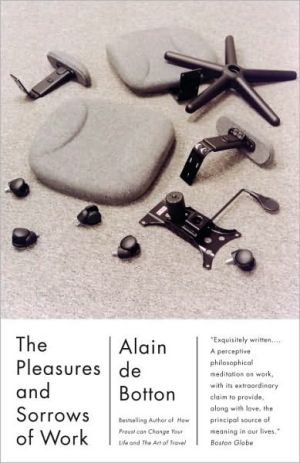The Pleasures and Sorrows of Work
We spend most of our waking lives at work-in occupations most often chosen by our inexperienced younger selves. And yet we rarely ask ourselves how we got there or what our jobs mean to us.\ The Pleasures and Sorrows of Work is an exploration of the joys and perils of the modern workplace. Here we see what other people wake up to do each day-and night-to make our frenzied world function. With a philosophical eye and his signature combination of wit and wisdom, Alain de Botton leads us on a...
Search in google:
We spend most of our waking lives at work—in occupations most often chosen by our inexperienced younger selves. And yet we rarely ask ourselves how we got there or what our jobs mean to us. The Pleasures and Sorrows of Work is an exploration of the joys and perils of the modern workplace, beautifully exploring what other people wake up to do each day—and night—to make our frenzied world function. With a philosophical eye and his signature combination of wit and wisdom, Alain de Botton leads us on a journey around an eclectic range of occupations, from rocket scientist to biscuit manufacturer, from accountant to artist—in search of what makes jobs either soul-destroying or fulfilling.The Barnes & Noble Review"What do you do all day?" children often ask their working parents. The activities of all but the most obvious occupations -- butcher, baker, candlestick maker -- can be especially mysterious and abstract, and not just to children. Brand supervision coordinator? Rocket scientist? The question has spawned numerous books, including Richard Scarry's children's classic What Do People Do All Day? and Studs Terkel's great oral history, Working (1974). In The Pleasures and Sorrows of Work, Alain de Botton explores some of the increasingly specialized fields of the workaday industrialized world -- cargo shipping, snack food product development, accountancy, airplane parts. He laments that most of us are woefully ignorant of, indifferent to, and disconnected from "the manufacture and distribution of our goods" and, indeed, from the machines and processes that facilitate our lives.
1.\ Imagine a journey across one of the great cities of the modern world. Take London on a particularly grey Monday at the end of October. Fly over its distribution centres, reservoirs, parks and mortuaries. Consider its criminals and South Korean tourists. See the sandwich- making plant at Park Royal, the airline contract-catering facility in Hounslow, the DHL delivery depot in Battersea, the Gulfstreams at City airport and the cleaning trolleys in the Holiday Inn Express on Smuggler’s Way. Listen to the screaming in the refectory of Southwark Park primary school and the silenced guns at the Imperial War Museum. Think of driving instructors, meter readers and hesitant adulterers. Stand in the maternity ward of St Mary’s Hospital. Watch Aashritha, three and a half months too early for existence, enmeshed in tubes, sleeping in a plastic box manufactured in the Swiss Canton of Obwalden. Look into the State Room on the west side of Buckingham Palace. Admire the Queen, having lunch with two hundred disabled athletes, then over coffee, making a speech in praise of determination. In Parliament, follow the government minister introducing a bill regulating the height of electrical sockets in public buildings. Consider the trustees of the National Gallery voting to acquire a painting by the eighteenth-century Italian artist Giovanni Panini. Scan the faces of the prospective Father Christmases being interviewed in the basement of Selfridges in Oxford Street and wonder at the diction of the Hungarian psychoanalyst delivering a lecture on paranoia and breastfeeding at the Freud Museum in Hampstead.\ Meanwhile, at the capital’s eastern edges, another event is occuring which will leave no trace in the public mind or attract attention from anyone beyond its immediate participants, but which is no less worthy of record for that. The Goddess of the Sea is making her way to the Port of London from Asia. Built a decade earlier by Mitsubishi Heavy Industries in Nagasaki, she is 390 metres long, painted orange and grey and wears her name defiantly, for she makes little attempt to evoke any of the qualities of grace and beauty for which goddesses are traditionally famed, being instead squat and 80,000 tonnes in weight, with a stern that bulges like an overstuffed cushion and a hold stacked high with more than a thousand variously-coloured steel containers full of cargo, whose origins range from the factories of the Kobe corridor to the groves of the Atlas Mountains.\ This leviathan is headed not for the better-known bits of the river, where tourists buy ice-creams to the smell of diesel engines, but to a place where the waters are coloured a dirty brown and the banks are gnawed by jetties and warehouses – an industrial zone which few of the capital’s inhabitants penetrate, though the ordered running of their lives and, not least, their supplies of Tango fizzy orange and cement aggregate depend on its complex operations.\ Our ship reached the English Channel late the previous evening and followed the arc of the Kent coastline to a point a few miles north of Margate, where, at dawn, she began the final phase of her journey up the lower Thames, a haunted-looking setting evocative both of the primeval past and of a dystopian future, a place where one half expects that a brontosaurus might emerge from behind the shell of a burnt-out car factory.\ The river’s ostensibly generous width in fact offers but a single, narrow navigable channel. Used to having hundreds of metres of water to play with, the ship now advances gingerly, like a proud creature of the wild confined to a zoo enclosure, her sonar letting out a steady sequence of coy beeps. Up on the bridge, the Malaysian captain scans a nautical chart, which delineates every underwater ridge and bank from Canvey Island to Richmond, while the surrounding landscape, even where it is densest with monuments and civic buildings, looks like the ‘terra incognita’ marked on the charts of early explorers. On either side of the ship, the river swirls with plastic bottles, feathers, cork, sea-smoothed planks, felt-tip pens and faded toys.\ The Goddess docks at Tilbury container terminal at just after eleven. Given the trials she has undergone, she might have expected to be met by a minor dignitary or a choir singing ‘Exultate, jubilate’. But there is a welcome only from a foreman, who hands a Filipino crew member a sheaf of customs forms and disappears without asking what dawn looked like over the Malacca Straits or whether there were porpoises off Sri Lanka.\ The ship’s course alone is impressive. Three weeks earlier she set off from Yokohama and since then she has called in at Yokkaichi, Shenzhen, Mumbai, Istanbul, Casablanca and Rotterdam. Only days before, as a dull rain fell on the sheds of Tilbury, she began her ascent up the Red Sea under a relentless sun, circled by a family of storks from Djibouti. The steel cranes now moving over her hull break up a miscellaneous cargo of fan ovens, running shoes, calculators, fluorescent bulbs, cashew nuts and vividly coloured toy animals. Her boxes of Moroccan lemons will end up on the shelves of central London shops by evening. There will be new television sets in York at dawn.\ Not that many consumers care to dwell on where their fruit has come from, much less where their shirts have been made or who fashioned the rings which connect their shower hose to the basin. The origins and travels of our purchases remain matters of indifference, although – to the more imaginative at least – a slight dampness at the bottom of a carton, or an obscure code printed along a computer cable, may hint at processes of manufacture and transport nobler and more mysterious, more worthy of wonder and study, than the very goods themselves.\ 2.\ The Goddess of the Sea is only one of dozens of ships making their way up the Thames on this October day. A Finnish vessel arrives from the Baltic Sea, laden with rolls of paper the width of railway tunnels, destined to feed the chattering presses of Wapping and West Ferry. A freighter sits low in the water next to Tilbury power station, weighed down by 5,000 tonnes of Colombian coal – enough fuel to fire the kettles and hairdryers of eastern England until the New Year.\ At a quayside, a car transporter opens its heavy-jawed cargo doors to emit three thousand family saloons which have spent twenty days at sea since leaving their assembly plant at Ulsan, on the Korean peninsula. These near-identical Hyundai Amicas, smelling of newly minted plastic and synthetic carpet, will bear witness to sandwich lunches and arguments, love-making and motorway songs. They will be driven to beauty spots and left to gather leaves in school car parks. A few will kill their owners. To peer inside these untouched vehicles, their seats wrapped in brown paper printed with elegant and cryptic Korean entreaties, is to have a feeling of intruding on an innocence more normally associated with the slumber of new-borns.\ But the port shows little interest in lyrical associations. Around Tilbury, the shipping companies present their services bluntly from within their smoked-glass headquarters. To reassure and seduce their clients, they imply that their vessels’ journeys – even those which involve rounding the Cape of Good Hope in winter, or shouldering thirty jet engines across the Pacific – have all the mundanity of a ride between adjoining stations on an Underground line.\ Nevertheless, no quayside can ever appear entirely banal, because people will always be minuscule compared to the great oceans and the mention of faraway ports will hence always bear a confused promise of lives unfolding there which may be more vivid than the ones we know here, a romantic charge clinging to names like Yokohama, Alexandria and Tunis – places which in reality cannot be exempt from tedium and compromise, but which are distant enough to support for a time certain confused daydreams of happiness.\ 3.\ In truth, the ships’ destination is not a single, cohesive port but rather a loose conjunction of terminals and factories untidily lining a stretch of the Thames between Gravesend and the Woolwich ferry. It is here that vessels slip in continuously, during humid summers and fog-bound winters, night and day, to deliver the bulk of London’s gravel and its reinforced steel, its soya beans and coal, its milk and its paper pulp, the sugar cane for its biscuits and the hydrocarbons for its generators – an area as noteworthy as any of the museums of the city, but about which the guidebooks are always silent.\ Numerous factories are situated on the very bank of the river, close enough to scoop or suck raw materials directly from the holds of ships, and are at work producing some of the less celebrated ingredients behind the smooth functioning of our utilitarian civilisation: the polyols added to toothpaste to help it retain its moisture, the citric acid used to stabilise laundry detergent, the isoglucose to sweeten cereal, the glyceryl tristearate to make soap and the xanthan gum to ensure the viscosity of gravy.\ In charge of these processes are engineers who have successfully stamped out their natural laziness to master the austere dilemmas of chemistry and physics, people who may have spent twenty years specialising in the storage of flammable solvents or the reaction of wood pulp to water vapour – and in their leisure time, leaf through the Hazardous Cargo Bulletin, the world’s only monthly magazine dedicated to the safe handling and transport of oils and chemicals.\ However inhuman the facilities of the port might seem in scale, it is in the end only our own personal and prosaic appetites that have created them. A river-side factory, with tubes like a hydra’s tentacles snaking around its midriff and crowned by a chimney wheezing orange smoke, is responsible for nothing more sinister or esoteric than the manufacture of cheddar biscuits. A tanker has crossed the muddy-brown North Sea from Rotterdam carrying carbon dioxide with which to make bubbles for children’s lemonade. The steely grey box of the Kimberly-Clark factory at Northfleet, eight storeys high and large enough to shelter an aircraft carrier, is turning out cartons of two-ply toilet roll. It is our collective tastes for sweets and nuts, drinks and tissues which has summoned ships from distant continents and thrown up industrial towers vying with the dome of St Paul’s.\ So arcane are the operations around the port that no single person could ever hope to grasp more than a fragment of their totality. A ship’s captain may enjoy superlative command over the contours of the lower Thames, but no sooner has his vessel docked than he will be relegated to the status of an apprentice observer of the business of jetty engineering and the long-term refrigeration of citrus fruit – his jurisdiction ending as abruptly as the authority of his nautical chart.\ However, any sadness we might feel about the demise of the generalist can be offset by the recognition that our age offers us access to unimpeachable masters of specific trades, for example, the storage of bitumen or the construction of ship-loading conveyors – in itself as comforting as the thought that there exist professors of medicine concentrated solely on the workings of human liver enzymes, or that at any time, several hundred scholars across the world are investigating nothing but the later Merovingian period of Frankish history, writing up their findings for the Zeitschrift für Archäologie des Mittelalters, an academic journal published by the humanities department at the University of Tübingen.\ The drift toward specialisation exists at the mechanical level too. The port area is filled with machines unavailable to the general public, which have none of the flexibility, but then again none of the dilettantish weaknesses, of generic conveyances like lorries and vans. They resemble peculiar-looking animals whose isolated habitats have rewarded the emergence of strange talents – the ability to suck beetles out of mud through one’s nose, for instance, or to hang upside down above an underground river – while forgiving a lack of more pedestrian skills. The R30XM2 lift-truck built by the Hyster Corporation of Cleveland, Ohio, may have a top speed of just five kilometres an hour, but in the restricted context of a warehouse, it skims gracefully along concrete floors and exhibits a balletic agility in extricating rolls of paper from the top shelves on either side of a tight aisle.\ It seems natural to admire the patience and nerves of those who have put up the money to build these limbs of industry, for example, the two hundred and fifty million dollars required merely to dip the keel of a trans-Pacific container ship into the water. The investors know that there is nothing implausible or hubristic in their appropriating the life savings of a nation’s postmen or nurses and then betting those sums on the financing of warehouses in Panama and back offices in Hamburg. They can let their funds disappear out of sight for a decade or more, leave them in the hands of captains and first officers, allow them to cross the Tropics of Capricorn and Cancer, sail the Long Island Sound and the Ionian Sea, dock in the container ports of Aden and Tangiers, confident that their investment will eventually sluice back to them swollen with the rewards of patience and application. They know that their outlay is in truth a form of prudence and incomparably less dangerous than leaving the money under the bed, to the eventual impoverishment and ruination of all.\ 4.\ Why, then, endowed as they are with both practical importance and emotional resonance, do the cargo ships and port facilities go unnoticed, except by those immediately involved in their operations?\ It is not just because they are hard to locate and forbiddingly signposted. Some of Venice’s churches are similarly secreted away but nonetheless prodigally visited. What renders the ships and ports invisible is an unwarranted prejudice which deems it peculiar to express overly powerful feelings of admiration towards a gas tanker or a paper mill – or indeed towards almost any aspect of the labouring world.\ Yet not everyone has been dissuaded. At the end of a pier in Gravesend, five men are standing together in the rain. They are dressed in waterproof plastic jackets and heavy-soled boots. They are silent and intent, looking out at the mist-cloaked river. They are tracking a shape, which they know from their timetables to be the Grande Nigeria. They also know that she is bound for Lagos, that her hold is filled with Ford parts for the African market, that she is powered by two Sulzer 900 diesel engines and that she measures 214 metres from stem to stern.
I Cargo Ship Spotting 11II Logistics 33III Biscuit Manufacture 69IV Career Counselling 105V Rocket Science 131VI Painting 171VII Transmission Engineering 193VIII Accountancy 225IX Entrepreneurship 269X Aviation 291
\ Caleb CrainDe Botton starts with noble intentions, claiming in his first chapter to have been inspired to write about work by the intense, unabashed interest taken by cargo-ship spotters, the hobbyists who track the comings and goings of the enormous oceangoing vessels that help to make globalization possible. The spotters "know what it is about the world that would detain a Martian or a child," de Botton writes. But in his praise of their wonder, there is a note of condescension: "Admittedly, the ship spotters do not respond to the objects of their enthusiasm with particular imagination. They traffic in statistics."\ —The New York Times\ \ \ \ \ Publishers WeeklyVeteran narrator David Colacci delivers an evenhanded, workmanlike performance of De Botton's philosophical exploration of the joys, pains and meaning of work. The erudite and frequently amusing meditation on vocation is accompanied by profiles of a broad spectrum of workers—employed in everything from biscuit manufacturing to rocket science, fishing to career counseling—with Colacci deftly capturing the text's perfect mix of sly humor and gravity and allowing listeners an opportunity to reflect on and question his or her own working life. A Pantheon hardcover (Reviews, Apr. 13). (June)\ \ \ Library JournalThis exploration of how and why we labor arrives at a poignant time, as global economic turmoil cuts off countless workers from their livelihoods-and the meaning work gives them. Essayist and novelist de Botton (How Proust Can Change Your Life) spends time with workers in England as well as the United States, including fishermen, rocket scientists, accountants, a landscape painter, and a career counselor, in pursuit of some fundamental truth about work. His conclusion is, perhaps unavoidably, elusive; he variously seems to praise commitment to a task and to deride it, to glorify and to condemn modern industry. De Botton filters his subjects' experiences through his own; though he is a witty, engaging interlocutor, his dominant voice distances the reader from those he aims to portray. Photographer Richard Baker contributes visual images of workers and workplaces, including a photo-essay documenting the process by which a tuna in the Indian Ocean becomes dinner for an English child. Providing provocative insights on specialization and the transitory nature of significance, this is sophisticated reading on a timely subject. [See Prepub Alert, LJ2/15/09.]\ —Janet Ingraham Dwyer\ \ \ \ \ \ Kirkus ReviewsNovelist/essayist de Botton (The Architecture of Happiness, 2006, etc.) turns his inquisitive eye to the business of work. For many of us, writes the author, the "unreasonable banality" of work requires "daily submission at the altars of prudence and order," typically housed in drab, soulless workplaces. (The many photographs are striking proof.) From the beginning of his latest philosophical excursion, however, de Botton appreciates that work is a meaningful act, if only in the most elemental sense-workers need to put food on the table. Still, the author found a certain heroic beauty in many of the work environments he visited, including that of an aircraft salesman, a biscuit manufacturer, an electricity-transmission engineer, a career counselor, a painter and an accountant. In each instance, he unhurriedly poked into the workings of the job, examined the possibilities for gleaning pleasure from it and embraced the Protestant worldview that "humility, wisdom, respect, and kindness could be practiced in a shop no less sincerely than in a monastery"-no matter how clownish-looking the activity, especially in an economy increasingly based on satisfying peripheral desires. There is something to be said about the delight generated by an artist's creations, or the happy, heedless energy of entrepreneurs, who require "a painfully uncommon synthesis of imagination and realism." Work may be trivial, de Botton notes, but what's interesting is the determination and gravity we bring to it. A luminous photo-essay from a consistently fresh and noble writer.\ \ \ \ \ The Barnes & Noble Review"What do you do all day?" children often ask their working parents. The activities of all but the most obvious occupations -- butcher, baker, candlestick maker -- can be especially mysterious and abstract, and not just to children. Brand supervision coordinator? Rocket scientist? \ The question has spawned numerous books, including Richard Scarry's children's classic What Do People Do All Day? and Studs Terkel's great oral history, Working (1974). In The Pleasures and Sorrows of Work, Alain de Botton explores some of the increasingly specialized fields of the workaday industrialized world -- cargo shipping, snack food product development, accountancy, airplane parts. He laments that most of us are woefully ignorant of, indifferent to, and disconnected from "the manufacture and distribution of our goods" and, indeed, from the machines and processes that facilitate our lives.\ The Swiss-born, Cambridge University–educated British writer and television documentarian is the author of several quirky self-help books, including How Proust Can Change Your Life, The Consolations of Philosophy, and Status Anxiety, all of which strive to demonstrate that philosophy and literature can offer practical, applicable usefulness. Their overarching theme is that happiness is within reach if you're willing to employ unusual -- generally intellectual -- tools to grasp it.\ De Botton's new book is more reportorial than scholarly and more peripatetic than contemplative -- but no less thought-provoking and unpredictable in its often delightfully unexpected angles and wry humor. Like his earlier books, Work is liberally illustrated, this time with black-and-white photographs of industrial sites, warehouses, office cubicles, and trade shows, mostly by his undercredited collaborator, photographer Richard Baker.\ In his prior volumes, de Botton has been essentially optimistic, convinced that existence is subject to improvement through our own rational efforts. His view is less rosy in The Pleasures and Sorrows of Work. Many of the tasks that consume a large share of workers' lives strike him as dreary and, worse, in service of trivial ends, such as the creation and marketing of McVities' new line of Moments cookies, which he follows from conception through manufacture and distribution. De Botton writes that this "disparity between a seriousness of means and a triviality of ends" can lead to disheartening "crises of meaning at our computer terminals and our warehouses, contemplating with low-level despair the banality of our labor while at the same time honoring the material fecundity that flows from it."\ Yet what surfaces repeatedly in de Botton's book is the extraordinary earnestness, sometimes bordering on obsessiveness, with which workers fulfill their appointed tasks. Could this tendency to "exaggerate the significance of what we are doing" be a remarkable self-survival technique? We may be overspecialized cogs in the machine, as de Botton suggests, but we perform our assigned duties with a sense that each cog is of vital importance. This not only affects manufacturers of airplane air hoses, but the critic writing this review.\ \ \ \ And, indeed, it also applies to de Botton's absorption in his book project. He describes languishing for days in Maldives while waiting for a fishing boat to be repaired in order to follow tuna from its source in the Indian Ocean to a Bristol supermarket. Walking the power line between a nuclear plant on the Kent coast to a substation in East London with an engineer who installs electricity pylons sparks his enthusiastic conclusion "that there were few troubling situations in contemporary life from which one could not distract oneself by wondering where the electricity had arrived from." In the Mojave Desert, he deflects a guard's verbal abuse with a bribe that enables him to poke around in an aviation graveyard while reflecting on mortality and decay, the flip side of progress. (This scene evokes Geraldine Chaplin in Robert Altman's Nashville reporting from a "graveyard" of parked school buses.)\ De Botton notes that it is only relatively recently in human history that work (rather than lineage) has come to define our identity, and that self-fulfillment -- in addition to money -- has become an important motivator. Like the poet Donald Hall, whose Life Work (1993) extols the advantages of loving what you do, de Botton is among the privileged minority fortunate enough to be able to set his own agenda.\ Although de Botton does consider people who are passionate about their work -- including some hopeful inventors and an artist who spends years painting the same oak tree over and over again in an East Anglia wheat field -- his primary focus is the more obscure, prosaic "limbs of industry." He clearly finds the soullessness of many jobs a source of horrified fascination -- a stance some may find vaguely condescending.\ Yet de Botton is at his best when describing how the most mundane efforts result in constructs of strange power and even beauty. He is awed by the collective effort of "engineers and technicians...these new medicine men" required to launch a satellite from French Guiana into space for beaming television broadcasts to Japan: "And yet, as a non-scientist examining the rocket-assembly building, gazing at a needle of solid propellant nine stories tall, one felt that a most unmagical of approaches had nevertheless succeeded in producing a device which was not entirely free of supernatural associations."\ What keeps us reading The Pleasures and Sorrows of Work is not so much the peek into cloistered industrial zones exposed by de Botton's reporting as the freshness of his observations and the ironic bite of his language. Of a particularly bleak tea shop along the electrical route, he comments, "How cheerful one would have needed to be in such a place in order not to regret existence." He likens accountants' "labyrinthine craft" to "numerical needlework" and admires that they "have accepted with grace the paucity of opportunities for immortality in audit." He wonders whether inventors, who must demonstrate "a judicious fusion of the utopian and the practical," are perhaps blessed with "a superior capacity for dissatisfaction" that propels them to come up with novel solutions to life's problems.\ As those desperately seeking employment in today's bleak economy are well aware, work itself is a solution to many of life's problems -- not just in providing financial wherewithal but distraction from greater anxieties, including mortality. Or, as the 19th-century Kansas poet Ironquill wrote:\ Work brings its own relief He who most idle is Has most of grief.\ --Heller McAlpin\ Heller McAlpin is a New Yorkbased book critic whose reviews appear regularly in the Los Angeles Times, San Francisco Chronicle, Boston Globe, and Christian Science Monitor, among other publications.\ \ \







